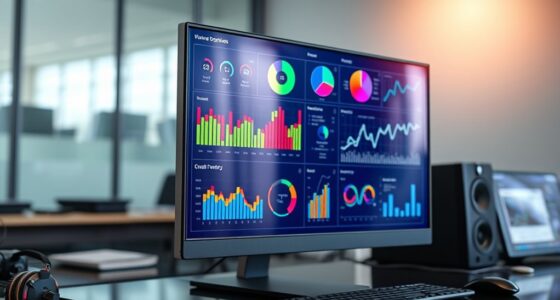To graph security events with open-source dashboards, start by selecting tools compatible with your data sources, like Grafana or Kibana. Collect and normalize logs from firewalls, servers, and IDS to guarantee consistent visualization. Focus on high-priority metrics, use clear visual cues like color coding, and customize layouts to highlight critical alerts. Automate data updates and set up anomaly detection to spot unusual activity. Keep exploring, and you’ll find steps to build an effective and scalable security visualization system.
Key Takeaways
- Choose an open-source dashboard tool compatible with your security data sources like JSON, SQL, or APIs.
- Normalize and aggregate logs from firewalls, IDS, and servers for consistent visualization.
- Use visual techniques such as line charts, heatmaps, and anomaly indicators to identify patterns and irregularities.
- Apply color coding to highlight critical alerts and prioritize security events effectively.
- Automate real-time data collection and alerts to maintain up-to-date security event graphing.
Understanding the Importance of Visualizing Security Data
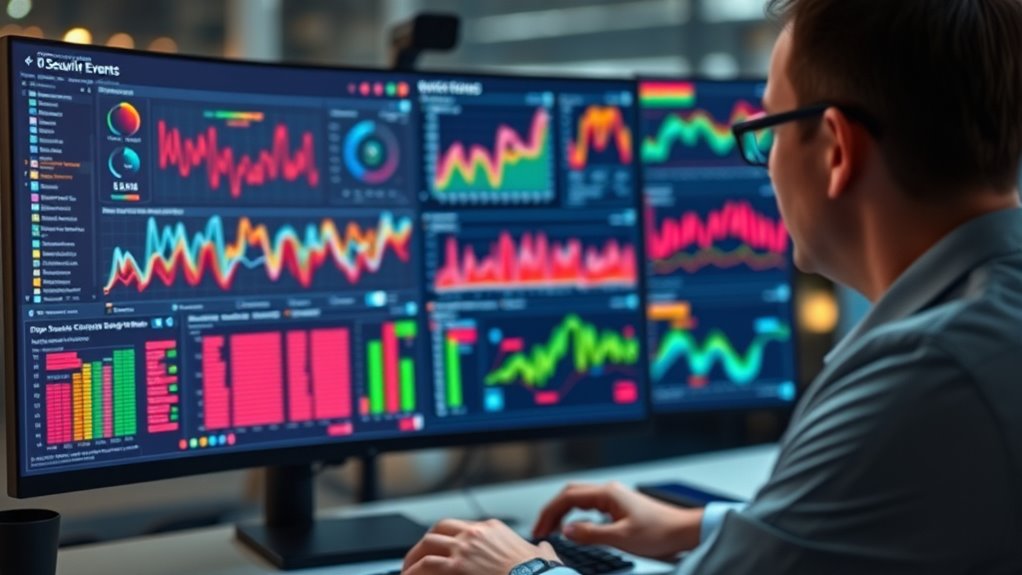
Visualizing security data is essential because it transforms complex information into clear, actionable insights. When you visualize security metrics, it becomes easier to identify patterns and anomalies that might otherwise go unnoticed. Data correlation allows you to connect different security events across systems, revealing relationships that help you understand the bigger picture. By graphing these connections, you can quickly spot unusual activity, track trends over time, and prioritize threats effectively. Visual representations simplify the analysis process, making it accessible even if you’re not a data expert. Additionally, understanding the contrast ratio in visual displays can enhance how effectively you interpret security charts and dashboards. Ultimately, this approach empowers you to make faster, more informed decisions, enhancing your overall security posture. Without visualization, critical signals can get lost in a sea of raw data, delaying crucial responses.
Selecting the Right Open-Source Dashboard Tools
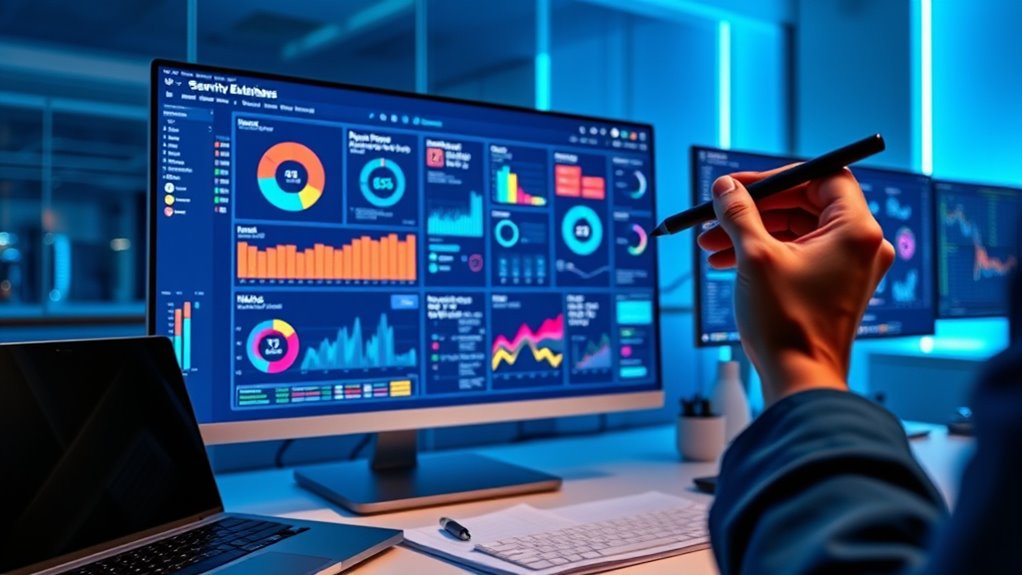
When choosing open-source dashboard tools, you need to contemplate how well they connect with your existing data sources. Look for options that offer strong customization features so you can tailor the visuals to your needs. Additionally, check if there’s an active community and reliable support, which can save you time and help troubleshoot issues quickly. Considering Advanced Techniques can also provide insights into implementing more sophisticated security event visualizations.
Compatibility With Data Sources
Choosing the right open-source dashboard tool hinges on guaranteeing compatibility with your data sources. You need to verify data source compatibility to seamlessly integrate various security logs, alerts, and metrics. Look for tools that support a wide range of data formats and protocols, such as JSON, SQL, or REST APIs. Integration flexibility is vital; the dashboard should easily connect with existing security systems and data pipelines without extensive customization. Consider whether the tool offers built-in connectors or plugins for your specific data sources. This ensures real-time updates and accurate visualizations. Additionally, assessing the Vetted – Grobal World of the tools can help ensure they are reliable and widely supported. By prioritizing compatibility and flexibility, you’ll streamline data ingestion and focus on analyzing security events effectively, rather than troubleshooting integration issues.
Customization Capabilities
Once you’ve confirmed that your dashboard tool can connect seamlessly with your data sources, the next step is to evaluate its customization capabilities. Look for options that allow you to tailor dashboard aesthetics to match your organization’s branding or visual preferences. User interface customization is key; you want a tool that lets you rearrange layouts, select color schemes, and modify widgets easily. This flexibility ensures your security events are displayed clearly and intuitively. Consider whether the dashboard supports custom themes or advanced styling features. A highly customizable interface allows you to focus on the most critical data, improving overall usability. Additionally, understanding industry trends can help you select a tool that remains adaptable to evolving security needs. By prioritizing these capabilities, you’ll create a more effective, visually appealing dashboard that enhances your security monitoring efforts.
Community and Support
How do you guarantee your open-source dashboard tool will be reliable and easy to maintain? Focus on community and support. A strong community engagement means you’ll find active users who share solutions and best practices, reducing your troubleshooting time. Check if the project has well-established support forums or chat channels where developers and users collaborate. These forums often provide quick responses to issues and valuable insights. An active community also indicates ongoing development, ensuring the tool stays updated and secure. Additionally, look for exhaustive documentation and regular releases. By choosing a dashboard with vibrant community engagement and accessible support forums, you’ll enhance reliability, simplify maintenance, and stay aligned with evolving security needs. Consistently monitoring open-source project activity helps ensure the tool remains current and trustworthy.
Setting Up Data Collection for Security Events
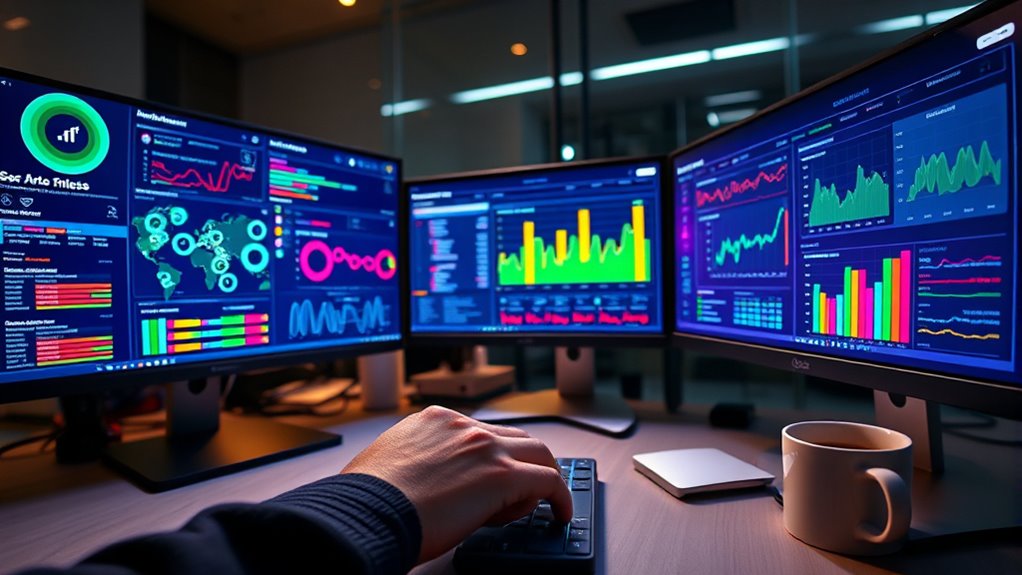
To effectively monitor security events, you need to set up a reliable data collection process. Start by aggregating logs from various sources like firewalls, servers, and intrusion detection systems. Ensure data normalization so that information from different formats aligns, making analysis more straightforward. This step is vital for consistent visualization and accurate insights. Next, implement alert prioritization to filter critical events from less urgent ones, reducing noise and focusing your attention on threats requiring immediate action. Automate data collection where possible to maintain real-time updates and reduce manual effort. Establishing a digital literacy approach to understanding and managing data can further enhance your ability to interpret security logs effectively. By establishing this foundation, you’ll create a streamlined, exhaustive view of your security landscape, allowing your dashboards to display relevant, normalized, and prioritized data for effective monitoring and swift response.
Designing Effective Security Event Visualizations

To make your security event visualizations effective, focus on representing your data clearly so insights are easy to grasp. Prioritize the most important metrics to highlight the issues that matter most, and use consistent color coding to avoid confusion. When you apply these principles, your visualizations become powerful tools for quick, accurate decision-making.
Clear Data Representation
Effective security event visualizations rely on clear data representation, ensuring that critical information is easily understood at a glance. You should use straightforward visuals to display security metrics clearly, avoiding clutter that can obscure key details. Highlighting alert thresholds helps you quickly identify when metrics exceed safe limits, allowing prompt response to potential threats. Use consistent color schemes and simple chart types to make patterns and anomalies stand out. Avoid complex or overly detailed visuals that can confuse viewers. Instead, focus on clarity, so stakeholders can grasp the severity of events instantly. By emphasizing simplicity and precision, your dashboards become powerful tools for monitoring security, enabling rapid decision-making and effective incident management. Incorporating visualization best practices can further enhance the effectiveness of your dashboards.
Prioritize Key Metrics
Focusing on the most important security metrics guarantees your visualizations deliver meaningful insights quickly. By emphasizing alert prioritization and metric significance, you ensure your dashboards highlight critical issues first. This prevents you from getting lost in irrelevant data and helps you respond swiftly. To evoke emotion and clarity, consider this table:
| High Priority Metrics | Medium Priority Metrics | Low Priority Metrics |
|---|---|---|
| Real-time alert volume | Past incident trends | Routine logs |
| Critical asset access | User login patterns | Background processes |
| Threat detection scores | Anomaly reports | System health checks |
Prioritizing these metrics keeps your focus sharp, making your dashboards both actionable and impactful. You’ll be better equipped to identify malicious activity, respond faster, and maintain a robust security posture. Monitoring critical asset access ensures you’re safeguarding essential resources effectively.
Use Consistent Color Coding
Using consistent color coding across your security visualizations helps users quickly interpret data and identify critical issues. Color consistency reinforces the visual hierarchy, guiding viewers to prioritize alerts and understand relationships. To maximize effectiveness:
- Assign specific colors to alert levels (e.g., red for critical, yellow for warning).
- Use the same colors consistently across dashboards for similar events.
- Avoid overusing colors, which can dilute visual hierarchy.
- Ensure color choices consider accessibility, such as color blindness.
This approach ensures users intuitively recognize severity and context, reducing confusion. Maintaining a standardized color scheme enhances clarity and speeds up decision-making, making your dashboards more actionable and reliable. Consistent color coding ultimately strengthens your security monitoring process by supporting quick, accurate insights.
Customizing Dashboards for Specific Security Needs

Customizing dashboards allows you to tailor security monitoring to your organization’s specific needs, making it easier to identify and respond to threats quickly. You can focus on key dashboard metrics relevant to your environment, such as network traffic, user activity, or system performance. Adjust the layout to highlight critical security alerts, ensuring they stand out for immediate action. By customizing widgets and views, you gain a clearer picture of your threat landscape, reducing noise from less relevant data. This personalization helps prioritize alerts and streamline investigation processes. Overall, customizing your dashboards enhances situational awareness, allowing you to react faster and more effectively to security events tailored to your organization’s unique security posture. Incorporating effective visualization techniques can further improve your ability to interpret complex security data at a glance.
Analyzing Trends and Detecting Anomalies
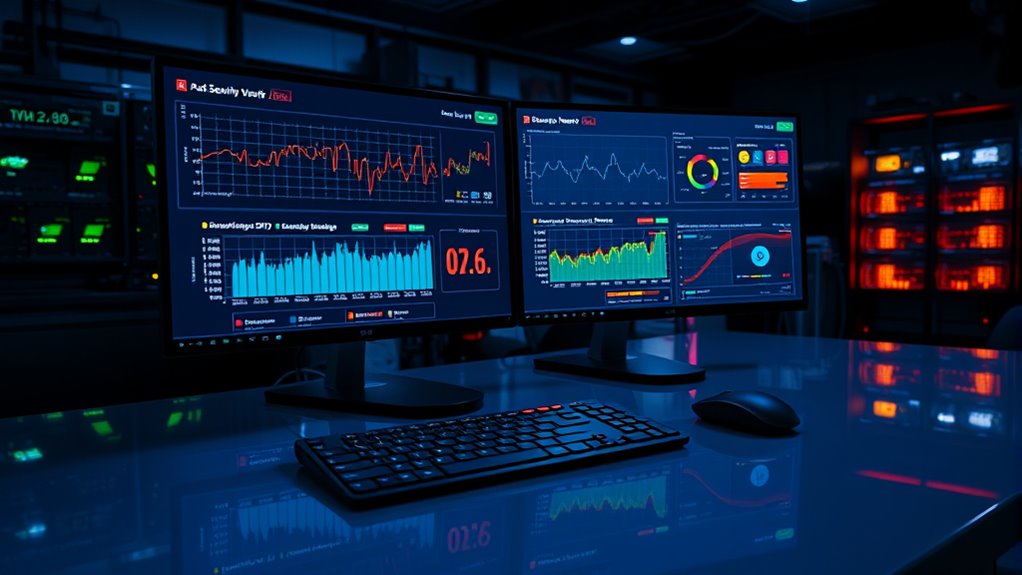
Have you ever wondered how to identify subtle security threats that don’t trigger obvious alerts? Analyzing trends and detecting anomalies involves examining behavior patterns over time to spot deviations. To sharpen your approach:
- Establish baseline behavior patterns to understand normal activity.
- Use open-source tools to visualize data and identify unusual spikes.
- Apply anomaly detection algorithms to flag irregular activity.
- Correlate anomalies with contextual data for deeper insights.
- Incorporate visualization techniques to better interpret data patterns and anomalies.
Maintaining and Scaling Your Security Dashboard Infrastructure

As your security operations grow, maintaining and scaling your dashboard infrastructure becomes essential to guarantee real-time visibility and effective response. Automated alerts help you promptly identify critical security events without constant manual monitoring, reducing response times. To support expansion, confirm your infrastructure can handle increased data volume and user access demands. Control user access carefully, assigning roles based on responsibilities to prevent unauthorized modifications and maintain data integrity. Regularly update your dashboards and underlying systems to incorporate new data sources and security metrics. Use scalable open-source solutions that allow you to add nodes or plugins as needed. Automating alert management and maintaining strict user access controls ensure your security dashboard remains reliable, responsive, and capable of supporting your growing security needs.
Frequently Asked Questions
How Can I Ensure Data Privacy While Visualizing Security Events?
To guarantee data privacy while visualizing security events, you should use data anonymization to remove or mask sensitive information. Additionally, apply encryption techniques to protect data both in transit and at rest. By combining these methods, you reduce the risk of exposing confidential details. Always verify your privacy measures regularly and restrict access to authorized personnel, ensuring your security event data remains protected while still providing valuable insights.
What Are Common Pitfalls in Open-Source Dashboard Implementations?
Imagine you’re steering uncharted waters—common pitfalls in open-source dashboard implementations can sink your project if you’re not careful. You might overlook the importance of proper dashboard customization, leading to cluttered visuals, or neglect data normalization, causing inconsistent insights. These issues can compromise clarity and accuracy. To avoid this, make certain you tailor your dashboards thoughtfully and standardize data inputs, making your security event visualizations both reliable and insightful.
How Do I Integrate Multiple Data Sources Seamlessly?
When integrating multiple data sources, you should focus on data normalization to guarantee consistency across datasets. Use source correlation to link related information from different sources, making your dashboards more insightful. Start by standardizing formats and units, then establish clear relationships between sources. This approach minimizes discrepancies and enhances your ability to analyze security events holistically, providing a clearer, more accurate picture of your security landscape.
What Are Best Practices for User Access Control on Dashboards?
Prioritize precise permissions and proactive policies to perfect your dashboard’s security. When managing user access control, assign specific user permissions based on roles, restrict sensitive data, and regularly review access rights. By balancing broad accessibility with strict security, you prevent potential breaches. Consistently check who can view, modify, or manage dashboards, ensuring only authorized users access critical information. Clear controls create a secure, streamlined, and smart security environment.
How Can I Automate Alerts Based on Dashboard Insights?
You can automate alerts based on dashboard insights by setting up alert automation rules within your monitoring tools. Use data anonymization techniques to protect sensitive info while analyzing patterns. When specific thresholds or anomalies are detected, the system can automatically trigger notifications via email or messaging platforms. This way, you stay proactive, respond swiftly to threats, and maintain data privacy, ensuring your security measures are both effective and compliant.
Conclusion
Don’t let fear of complex setup hold you back. With open-source dashboards, you have powerful tools at your fingertips to visualize security events clearly and quickly. By taking control now, you can spot threats early and protect what matters most. Yes, it takes effort, but your proactive approach can make all the difference. Embrace these tools and turn security data into your strongest defense—because your peace of mind is worth it.




